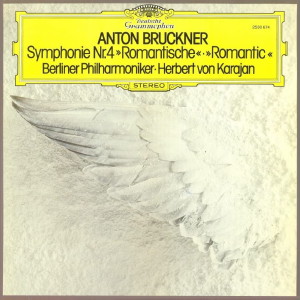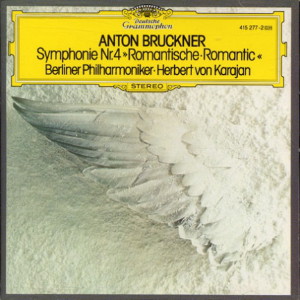 |
|
1 LP -
2530 674 - (p) 1976
|
 |
| 1 CD -
415 277-2 - (c) 1985 |
|
| ANTON BRUCKNER
(1824-1896) |
|
|
|
|
|
|
|
| Symphonie
Nr. 4 Es-dur "Romantische" |
|
63' 56" |
|
| Versione: 1880:
edizione: Robert Haas |
|
|
|
| -
1. Bewegt, nicht su schnell |
18' 17" |
|
|
| -
2. Andante quasi Allegretto |
14' 29" |
|
|
| -
3. Scherzo. Bewegt |
10' 43" |
|
|
| -
4. Finale. Bewegt, doch nicht zu
schnell |
20' 27" |
|
|
|
|
|
|
| Berliner
Philharmoniker |
|
| Herbert von KARAJAN |
|
|
|
|
|
Luogo
e data di registrazione |
|
Philharmonie,
Berlino (Germania) - aprile 1975 |
|
|
Registrazione:
live / studio |
|
studio |
|
|
Production |
|
Dr.
Hans Hirsch, Magdalene Padberg |
|
|
Recording
Supervision |
|
Michel
Glotz |
|
|
Recording Engineer |
|
Günter
Hermanns |
|
|
Prima Edizione LP |
|
Deutsche
Grammophon - 2530 674 - (1 LP) -
durata 63' 56" - (p) 1976 -
Analogico |
|
|
Prima Edizione CD |
|
Deutsche
Grammophon - 415 277-2 - (1 CD) -
durata 63' 56" - (c) 1985 - ADD |
|
|
Note |
|
Cover
Design: Holger Matthies, Hamburg
|
|
|
|
|
Anton
Bruckner’s Fourth Symphony,
known as the “Romantic”,
which he composed in 1874
and substantially revised
between 1878 and 1880, has
always been the most popular
of all his works. During
Bruckner’s lifetime the
Fourth, together with the
Seventh, received more
performances than any of his
other symphonies; the world
première of the Fourth,
which took place in Vienna
on 20 February 1881, was a
great success (especially
striking after the failure
of the Third), and Bruckner
considered this to be the
“most understandable” of his
works. Undoubtedly the
popularity of this symphony
derives from its well-judged
formal structure, its mode
of expression, the immediacy
of its melodic ideas, and
the radiance of its tone
colours. The fact that the
“Romantic” represents in
some ways a turning point in
its composer’s symphonic
writing is indicated
initially by “technical”
details: it is not only
Bruckner’s first symphony in
a major key (the five
preceding symphonies are all
in minor keys), but also his
first symphonic work in
which the alternation of
major and minor, above all
the blending of their
characteristic moods -
particularly the
overclouding of major
tonality by elements of the
minor, so characteristic of
romantic harmony - has
become so prominent that it
ranks as a constructive
principle. (This is
especially clear, for
example, in the principal
theme of the first movement,
or in the second subject of
the Finale, at C in the
score). It is within the
bounds of possibility that
it was partly this aspect of
the work, combined with
Bruckner’s predilection for
the sound of horns and for a
sense of mystery, which
caused him to give this
Fourth Symphony the name
“The Romantic”, with its
many shades of meaning. It
would scarcely be possible
to overlook the strong
affinity which this symphony
has with the early romantic
sound world of Schubert and
Weber, while on the other
hand it also bears witness
to the powerful influence of
Wagner, especially in the
outer movements (to mention
only one example, the
splendid chorale-like brass
passage in the development
of the first movement, 18
bars after K).
In the case of the Fourth
Symphony the question
inevitably arises concerning
the programmatic
associations of Bruckner’s
symphonic writing. In
conversation with his
friends and in letters,
Bruckner later made
hermeneutic explanations (or
rather suggestions)
concerning this work. As
with the Eighth, these do
not by any means constitute
an organized programme, and
they are of far less
importance than the work’s
purely musical contents. In
conjunction with other
observations, however, they
indicate that extra-musical
impulses played a certain
part in the process of
composition. This is true,
for example, as regards the
lyrical second theme of the
first movement (at B), whose
motif kernel, the three
notes F2-F2-A1 Bruckner
referred to as the chirping
(“zi-zi-bee”) of the forest
tomtit, while the
counter-melody of the viola
expresses, according to T,
Helm, “one’s own feeling of
joy at being able to listen
to such charming voices of
nature in the woods”.
Pictorial images also seem
to have influenced Bruckner
when he composed the hunting
Scherzo and the Finale, to
which he gave the title
“Popular Festival” in the
first revision of 1878. A
comparison with Beethoven’s
“Pastoral” inevitably
suggests itself, despite the
fact that the elements of
tone poetry in the Fourth
are of an entirely different
order. While the
extra-musical impulses are
of undoubted importance, the
“Romantic” cannot be
considered an out-and-out
German programmatic
symphony: both the formal
layout of the work and its
entire construction contain,
apart from a few motif
ideas, no peculiarities or
anomalies which can be
explained only by reference
to a detailed programme.
Typically enough, Bruckner’s
outline of the first
movement gives no more than
a general idea of the ideas
behind it: “Medieval town -
dawn - morning calls are
heard from the towers - the
gates open - knights ride
out on proud horses, the
magic of the woodland
surrounds them - forest
murmurs - birdsong - so the
romantic picture unfolds
itself.” (It is evidently on
the basis of this
programmatic sketch that the
“Romantic” has been
described as a “Forest
Symphony”, and its contents
are sometimes considered to
represent the “mysticism of
nature”.)
In the C minor Andante the
unmistakable features of a
funeral march come to the
fore. They give the elegiac
principal subject its
character, while the
transitional section (if the
passage at B may be so
described) and second theme
(i.e. the expressive viola
melody with pizzicato
accompaniment) are
chorale-like. Of the two
climaxes in the principal
theme (at E in the
development and at M in the
Coda) the second is far
greater in intensity than
the first.
The Scherzo and Trio of the
original version were
replaced by entirely new
pieces when the work was
revised in 1878. The
somewhat impressionistic B
flat major Scherzo of the
final version, which is
based on two themes, is far
more than a mere hunting
piece, and even the far
simpler, surprisingly
delicate, ländler-like Trio
in G flat major belongs to a
realm of expression far
removed from that suggested
by the original heading of
the piece “Dance tune at
mealtime on the hunt”.
The Finale exists in no
fewer than three different
versions. At the last
revision of 1880 this
movement was so drastically
rewritten that it completely
lost the cheerful character
which it had possessed in
the first version. Not only
were several of the original
melodic ideas replaced by
new, sometimes dramatic and
even demoniac elements, but
certain sections took on
darker colouring, and
therefore wholly different
characteristics. Among other
new features there is the
return of the horn fanfares
from the Scherzo during the
extensive crescendo which
introduces the weighty
principal theme of the
Finale, played in unison.
The very idea of
transferring the earlier
title “Popular Festival” to
this movement, which is now
full of strong contrasts and
powerful tensions, would be
strikingly ironical.
Constantin
Floros
(Translated
from the German)
|
|
|